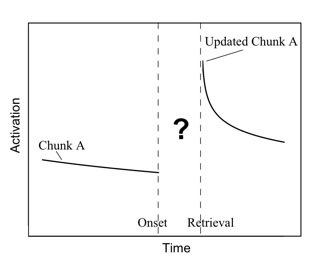Speaker at ACT-R Workshop this summer
16-04-09 15:08
Next July I will speak at the ACT-R workshop that precedes the Annual Cognitive Science Conference in Amsterdam. The workshop will focus on recent developments in the cognitive architecture itself, and I will present our work on the memory retrieval theory RACE/A. The abstract of my talk is below.
In ACT-R’s declarative memory, each chunk has a certain activation level that determines the retrieval latency and the probability of retrieval for a chunk. For many cognitive modeling efforts, this information is precise enough to simulate memory processes. In some cases, however, a more fine-grained process model of declarative memory retrievals is required. For instance, information that becomes available during the retrieval of a chunk may affect the retrieval latency of that chunk. A prototypical example of this is the Stroop task. In the Stroop task, naming the color of a word that describes another color (e.g., the word “red” written in green letters) takes on average longer than naming the color of a neutral word (e.g., the word “dog” written in green letters). This is even the case if the color and the word are temporally separated (e.g., if the color word is presented after the color itself), which is difficult to explain with the default ACT-R declarative memory theory.

We developed an extension to ACT-R (called Retrieval by Accumulating Evidence in an Architecture or RACE/A, Van Maanen, 2009; Van Maanen & Van Rijn, 2007) that provides a specification of the activation dynamics during the declarative memory retrieval process. RACE/A describes memory retrievals as a sequential sampling process (e.g., Ratcliff, 1978). During a memory retrieval the activation of all chunks is continuously updated based on spreading activation from stimuli and other chunks in declarative memory. A chunk is retrieved if the activation of that chunk exceeds the activation of the others by a critical ratio (e.g., Luce, 1986). As a result, if the activation of multiple chunks increases simultaneously, the retrieval process will take longer. In the case of the Stroop task, spreading activation between the chunk representing the color and the color word causes both chunks to accumulate activation, leading to a longer retrieval process than if word and color are unrelated (e.g., “dog” and the color red), in which case there is no spreading activation.
In this talk, I will go into the principles underlying RACE/A, and I will provide examples of tasks that can be explained using RACE/A. RACE/A is available as a separate module for ACT-R (which can be downloaded from http://www.ai.rug.nl/~leendert/race). The module enables cognitive scientists to develop ACT-R models with a more fine-grained theory of declarative memory.
References
In ACT-R’s declarative memory, each chunk has a certain activation level that determines the retrieval latency and the probability of retrieval for a chunk. For many cognitive modeling efforts, this information is precise enough to simulate memory processes. In some cases, however, a more fine-grained process model of declarative memory retrievals is required. For instance, information that becomes available during the retrieval of a chunk may affect the retrieval latency of that chunk. A prototypical example of this is the Stroop task. In the Stroop task, naming the color of a word that describes another color (e.g., the word “red” written in green letters) takes on average longer than naming the color of a neutral word (e.g., the word “dog” written in green letters). This is even the case if the color and the word are temporally separated (e.g., if the color word is presented after the color itself), which is difficult to explain with the default ACT-R declarative memory theory.

We developed an extension to ACT-R (called Retrieval by Accumulating Evidence in an Architecture or RACE/A, Van Maanen, 2009; Van Maanen & Van Rijn, 2007) that provides a specification of the activation dynamics during the declarative memory retrieval process. RACE/A describes memory retrievals as a sequential sampling process (e.g., Ratcliff, 1978). During a memory retrieval the activation of all chunks is continuously updated based on spreading activation from stimuli and other chunks in declarative memory. A chunk is retrieved if the activation of that chunk exceeds the activation of the others by a critical ratio (e.g., Luce, 1986). As a result, if the activation of multiple chunks increases simultaneously, the retrieval process will take longer. In the case of the Stroop task, spreading activation between the chunk representing the color and the color word causes both chunks to accumulate activation, leading to a longer retrieval process than if word and color are unrelated (e.g., “dog” and the color red), in which case there is no spreading activation.
In this talk, I will go into the principles underlying RACE/A, and I will provide examples of tasks that can be explained using RACE/A. RACE/A is available as a separate module for ACT-R (which can be downloaded from http://www.ai.rug.nl/~leendert/race). The module enables cognitive scientists to develop ACT-R models with a more fine-grained theory of declarative memory.
References
- Luce, R. D. (1986). Response times. New York: Oxford UP.
- Ratcliff, R. (1978). A theory of memory retrieval. Psychological Review, 85(2), 59-108.
- Van Maanen, L. (2009). Context effects on memory retrieval: Theory and applications. Doctoral thesis, University of Groningen, Groningen.
- Van Maanen, L., & Van Rijn, H. (2007). An accumulator model of semantic interference. Cognitive Systems Research, 8(3), 174-181.
